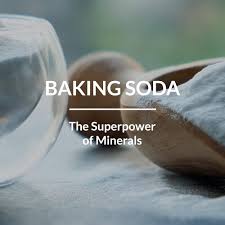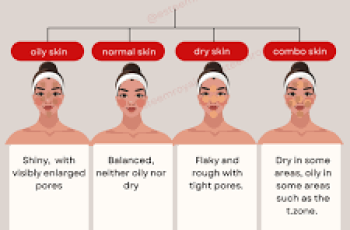Here’s the Truth About Using Baking Soda as a DIY Acne Treatment
We’d be willing to bet that you have at least one box of baking soda currently stashed in the kitchen. Whether it’s in the pantry waiting to be mixed into your go-to chocolate chip cookie recipe or under the sink ready to be used as part of a make-your-own cleaner, there’s no denying that baking soda wins in the versatility department. That being said, contrary to what you may have heard, there’s one place where you shouldn’t use baking soda without abandon: The face.
Baking soda has been anecdotally used as a DIY mask or spot treatment for acne. However, according to top dermatologists Marnie Nussbaum, MD, FAAD, and Annie Gonalez, MD, this ingredient may do more harm than good when added to your skincare routine. To get our facts straight, we asked the experts for their thoughts on using baking soda to fight acne.
Ahead, find how to use baking soda safely, as well as its benefits and potential side effects when used on the skin.
Meet the Experts
Marnie Nussbaum, MD, FAAD, is a New York City-based board-certified dermatologist specializing in non-invasive aesthetic rejuvenation.
Annie Gonzalez, MD, is a board-certified dermatologist and founder of Glösense Dermatology & Aesthetics in Miami.
What Is Baking Soda?
Also known as sodium bicarbonate, baking soda is a chemical compound with alkalinizing properties and is technically classified as a salt, explains Nussbaum. The alkalinizing part is super important when it comes to using baking soda in skincare and for acne, but per that same point, it’s why baking soda helps neutralize acidic substances, both internally and externally, points out Gonzalez.
Baking Soda
Type of Ingredient: Exfoliant
Potential Benefits: Exfoliates, offers anti-inflammatory properties, and may help balance out the pH for those with oilier skin.
Who Should Use It: Only those who are in a pinch and don’t have access to products that use ingredients specifically formulated to fight acne, such as salicylic acid and benzoyl peroxide, cautions Nussbaum. Generally speaking, it’s also a better option for oilier skin types, adds Gonzalez, but it can be problematic even then.
How Often Can You Use It: No more than once per week.
Works Well With: Mix it only with water to create a spot treatment.
Don’t Use With: Because baking soda may be very drying, don’t use it with other potentially drying skincare ingredients, such as retinoids or acids.
There’s no denying that baking soda can play a role in many at-home beauty treatments, not to mention that it’s an insanely affordable ingredient for these purposes. It’s a potential physical exfoliant; it can step in for dry shampoo in a pinch and make for a great foot soak. It can easily be turned into toothpaste and is a star ingredient in many natural deodorants (both DIY recipes and ready-made options). You get the picture. But where things start to get a little dicey, and you need to proceed with caution is when using baking soda on your face and for acne-fighting purposes.
Benefits of Baking Soda for Acne
There are some; there wouldn’t be tons of articles singing its praises as a natural zit-zapping solution if there weren’t. Take a look at some notable benefits below:
Exfoliates: Baking soda’s slightly gritty texture means it has an exfoliating effect, says Nussbaum. Exfoliating is one way to help keep pores from becoming clogged and prevent blackheads, whiteheads, and red pimples from forming.
Offers anti-inflammatory properties: According to Gonzalez, baking soda is anti-inflammatory. It’s why it’s often found in many over-the-counter topical products meant to soothe minor skin irritations such as bug bites and rashes, she points out. And, by default, this is why it could be beneficial for quelling red, inflamed breakouts, she adds.
Can help balance out the pH for those with oilier skin: For context, let’s start with a quick high school chemistry class refresher: The pH scale runs from 0 to 14, with 7 being neutral. Anything below 7 is acidic, and anything above is alkaline. Our skin is typically acidic, with a pH between 4 and 6.1 “This is a healthy level that maintains moisture while also protecting it from bacteria and pollution,” explains Gonzalez. However, “If your skin is more acidic than average, it can lead to an excess production of sebum (your skin’s natural oils), which can clog pores and cause acne,” adds Nussbaum. In that case, the alkaline nature of baking soda can help balance the skin and bring it back to a healthier pH, according to Nussbaum.
Potential Side Effects
Because baking soda is so alkaline—it has a pH of about 9—it can easily disrupt your skin’s natural pH levels by over-stripping the natural oils, resulting in dry, irritated, and inflamed skin, cautions Nussbaum. Messing with your skin’s pH may also lead to premature wrinkles and, ultimately, even exacerbate existing acne, warns Gonzalez.
In short, baking soda does offer the aforementioned benefits, but there’s a super fine line between reaping said benefits and quickly veering into irritated skin territory. That’s why both doctors we spoke with warn against using it as part of a DIY acne-fighting routine.
How to Use It
If you still want to take baking soda for a test run, remember that, first and foremost, the oilier your skin is, the less likely you are to run into issues. In other words, if your complexion is dry and sensitive to begin with, this is definitely not the ingredient for you. Secondly, small amounts used infrequently are safest. Nussbaum suggests mixing approximately two teaspoons of baking soda with enough water to form a paste-like consistency and applying it as a targeted spot treatment onto blemishes only. To clarify, don’t slather it across your entire complexion as an all-over face mask. Leave it on for five to 10 minutes before gently rinsing with tepid water—and do this no more than once per week, Nussbaum says. Since there’s also the potential for it to dry out your skin, be extra diligent about moisturizing and SPF usage.
If you experience any adverse side effects, such as redness, dryness, irritation, or flaking, after using baking soda as a spot treatment, seek treatment from a board-certified dermatologist.
The Final Takeaway
Ultimately, baking soda—a chemical compound with alkalinizing properties—may be best left for kitchen or household cleaning uses. It can easily disrupt your skin’s natural pH levels by over-stripping the natural oils, resulting in dry, irritated, and inflamed skin. Before trying out baking soda as a water-mixed, paste-like spot treatment, remember that the oilier your skin is, the less likely you are to encounter any issues. If you experience any adverse effects, such as redness, dryness, irritation, or flaking, from using baking soda as a spot treatment, consult a board-certified dermatologist.
DQH Knowledge drop: In your 20s, your skin cell turnover decreases. (Cell turnover is a key component in keeping your skin youthful.) You know what else slows down? Your collagen production. Starting in your 20s, collagen decreases by about 1 percent per year. Should you want to prevent fine lines and wrinkles, start by eliminating behaviors that contribute to premature aging. “If it’s bad for you, it’s bad for your skin,” says dermatologist Michel Somenek.
“Cigarette smoking reduces blood flow to the skin and causes premature wrinkling and a dull skin texture. Making the repeated pursed motion to inhale can also cause smoker’s lines. Alcohol and recreational drugs are toxins for the skin that damage its cellular structure and DNA,” Somenek tells us. “The faster you eliminate vices while you are young, the better chance your skin and body have to recuperate.” Also, adopting an anti-aging routine in your 20s is key. After all, the best offense is a good defense. We spoke to Somenek and experts Joshua Ross and Audrey Kunin to find out more.
Keep reading for the best anti-aging products for your 20s, according to skincare professionals.
Sunscreen
“We all know that the sun is the number one cause of skin aging and starting the prevention in your 20s is very important,” Ross says. “The majority of your sun damage won’t start to appear until you’re in your 30s, so don’t wait until you see it surface or you’ll be behind the curve. Stay ahead of it with a good-quality zinc-based sunscreen worn daily.”
Farmacy Green Defense Daily Mineral Sunscreen
An invisible sunscreen with SPF 30, plus botanical extracts meant to protect skin with tons of antioxidants. Bonus: It’s clean and fine to use under makeup.
Bareminerals Complexion Rescue™ Tinted Moisturizer Broad Spectrum SPF 30
Although we recommend you use your SPF and moisturizer separately, we also understand moments when you don’t have time or energy for that extra step. For those times, this bareMinerals moisturizer is a great thing to have on hand.
Vitamin C Serum
“A great introduction to anti-aging is to start with a vitamin C serum in your morning skincare routine,” Ross says. “It’s a powerful antioxidant that will neutralize free radicals and brighten the skin.” He adds that it’s a great way to counteract the effects of the sun’s harmful rays, which, as previously mentioned, are among the biggest causes of premature aging.
Drunk Elephant C-Firma™ Vitamin C Day Serum
The Drunk Elephant C-Firma is a lightweight serum that promises to give skin a glow by combining the brightening powers of vitamin C with ferulic acid, l-ascorbic acid, and vitamin E. The included sodium hyaluronate is meant to replace hydration loss, so you shouldn’t have to deal with any irritation.
Sunday Riley C.E.O. Rapid Flash Brightening Serum
This potent serum is jam-packed with vitamin C (15 percent, to be exact), which means it’s a potential superstar at both brightening skin and dousing it in antioxidants.
Peptides
Using peptides on your skin has many benefits, says Somenek. “The skin barrier is what defends the body against pollution, UV rays, bacteria, and toxins. It can be damaged by several everyday factors. Using topical peptides aids in building a stronger barrier,” he says. “Peptides comprise elastic fibers, which are a type of protein. These fibers help to make skin appear taut and firm. Peptides can also help repair damaged skin, relieve inflammation, and even out skin tone. Some peptides can kill acne-causing bacteria that is common in 20-somethings.”
Kunin agrees, saying, “Peptides are an excellent entry point for supporting collagen.” She recommends looking for face and eye treatments that contain these collagen-boosting powerhouses.
Charlotte Tilbury Magic Eye Rescue Cream
This Charlotte Tilbury super-emollient eye cream has a base of coconut oil and shea butter (read: it’s incredibly hydrating). Botanicals plus peptides are meant to help reduce dark circles and boost collagen, respectively.
This creamy moisturizer serves up potent collagen-boosting peptides and pycnogenol, and antioxidant-rich vitamin C. “Instead of sitting on top of the skin, peptides penetrate the outer layer so they go deep. The ‘signals’ they send tell the cells to produce elastin and collagen, which are needed for youthful-looking skin,” explains Somenek.
At-Home Peel Pads
Remember that skin cell turnover fiasco we talked about earlier? One way to help support it is by exfoliating. “Exfoliation is important to help keep skin fresh and luminous,” Kunin says. She recommends using at-home peel pads as an easy and effective way to exfoliate.
“The goal in your 20s is to fight the slowing pace of cell turnover. It is wise to use products that gently exfoliate, yet still remove oil and other impurities. Products that have Alpha Hydroxy Acids (AHA) or Beta Hydroxy Acids (BHA) are a good choice.”
According to Somenek, you should only exfoliate two to three times a week. “People of all ages are guilty of over-exfoliating and that can be too much of a good thing,” he says.
Dermadoctor Kakadu C Intensive Vitamin C Peel Pad
A few swipes of this Derma Doctor powerful peel pad promise to leave your skin glowing and smooth, thanks to the seven (yes, seven) types of chemical exfoliants, including AHA and BHA. It also contains vitamin C via Kakadu plum extract for added brightening and antioxidant protection.
KEY INGREDIENTS Kakadu plum extract is sourced from the Kakadu plum, a fruit grown in northern Australia. It contains vitamin C, which restores the skin’s natural barrier, increases collagen production, and soothes irritation.
Dr. Dennis Gross Skincare Alpha Beta® Universal Daily Peel Pads
These are the gold standard of peel pads, with a cult following and over 900 five-star reviews on Sephora. They’re easy to use and contain a blend of anti-aging exfoliating acids.
Emollient Night Cream
“In your 20s, you need to start upping the hydration in your skincare routine. You may have been cautious of over-moisturizing because of acne in your teens, but as you enter your 20s, your skin transitions and becomes drier,” Ross says. “I recommend an emollient night cream added into your evening skincare regimen.”
“Twenty-somethings need to make sure that they are not using creams that will clog their pores and cause excess oil production,” says Somenek. Opt for non-comedogenic products.
Cerave Skin Renewing Night Cream
One great choice is the CeraVe Skin Renewing Night Cream, which is a non-comedogenic night cream that leaves skin soft and glowy. It combines the moisturizing powers of ceramides and hyaluronic acid.
RoC Retinol Correxion Max Hydration Creme
“The best night cream ingredients contain retinol, benzoyl peroxide, and/or salicylic acid or hyaluronic acid. The goal is to moisturize, yet remove excess oil,” says Somenek. This Roc Retinol Correxion cream fits the bill as it contains both hyaluronic acid and retinol so it promises to moisturize while also being non-comedogenic.



